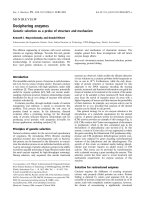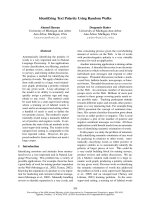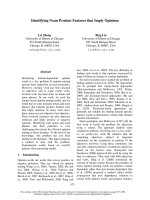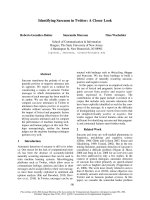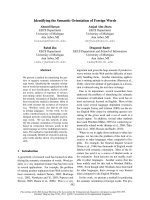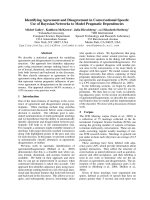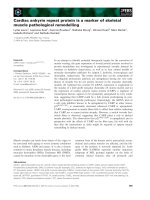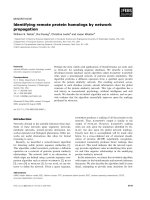báo cáo khoa học: "Identifying quality improvement intervention publications - A comparison of electronic search strategies" pot
Bạn đang xem bản rút gọn của tài liệu. Xem và tải ngay bản đầy đủ của tài liệu tại đây (263.4 KB, 10 trang )
RESEARCH Open Access
Identifying quality improvement intervention
publications - A comparison of electronic search
strategies
Susanne Hempel
1*
, Lisa V Rubenstein
1,2,3,4
, Roberta M Shanman
1
, Robbie Foy
5
, Su Golder
6
, Marjorie Danz
1
and
Paul G Shekelle
1,2,3
Abstract
Background: The evidence base for quality improvement (QI) interventions is expanding rapidly. The diversity of
the initiatives and the inconsisten cy in labeling these as QI interventions makes it challenging for researchers,
policymakers, and QI practitioners to access the literature systematically and to identify relevant publications.
Methods: We evaluated search strategies developed for MEDLINE (Ovid) and PubMed based on free text words,
Medical subject headings (MeSH), QI intervention components, continuous quality improvement (CQI) methods,
and combinations of the strategies. Three sets of pertinent QI intervention publications were used for validation.
Two independent expert reviewers screened publications for relevance. We compared the yield, recal l rate, and
precision of the search strategies for the identification of QI publications and for a subset of empirical studies on
effects of QI interventions.
Results: The search yields ra nged from 2,221 to 216,167 publications. Mean recall rates for reference publications
ranged from 5% to 53% for strategies with yields of 50,000 publications or fewer. The ‘best case’ strategy, a simple
text word search with high face validity (’quality’ AND ‘improv*’ AND ‘intervention*’) identified 44%, 24%, and 62%
of influential intervention articles selected by Agency for Healthcare Research and Quality (AHRQ) experts, a set of
exemplar articles provided by members of the Standards for Quality Improvement Reporting Excellence (SQUIRE)
group, and a sample from the Cochrane Effective Practice and Organization of Care Group (EPOC) register of
studies, respectively. We applied the search strategy to a PubMed search for articles published in 10 pertinent
journals in a three-year period which retrieved 183 publications. Among these, 67% were deemed relevant to QI
by at least one of two independent raters. Forty percent were classified as empirical studies reporting on a QI
intervention.
Conclusions: The presented search terms and operating characteristics can be used to guide the identification of
QI intervention publications. Even with extensive iterative development, we achieved only moderate recall rates of
reference publications. Consensus development on QI reporting and initiatives to develop QI-relevant MeSH terms
are urgently needed.
Background
Quality improvement (QI) interventions account for
substantial investments by organizations seeking to
improve the quality of care. A large volume of literature
docum ents many of these efforts. Advancement in clini-
cal areas often depends heavily on identifying and
synthesizing the exist ing evidence in systematic reviews.
To facilitate reviews of QI interventions, the first step is
to evaluate electronic search strategies for retrieving
relevant articles; inadequate searching reduces the relia-
bility, validity, and utility of all subsequent review steps.
Searches for quality improvement interventions are
challenging for a variety of reasons. Researchers have
only recently begun to develop a common understand-
ing of quality improvement interventions, to recognize
* Correspondence:
1
RAND Corporation, Santa Monica, CA 90407, USA
Full list of author information is available at the end of the article
Hempel et al. Implementation Science 2011, 6:85
/>Implementation
Science
© 2011 Hempel et al; licensee BioMed Central Ltd. Thi s is an Open Access article distributed under the terms of the Creative Commons
Attribution License (http://crea tivecommons.org/licenses/by/2.0), which pe rmits unrestricted use, distribution, and re prod uction in
any medium, provide d the origin al work is properly cited.
the features that distinguish these from other interven-
tions, and to promote the need for reporting standards
[1,2]. Reaching agreement on how to define and apply a
common label that sufficiently captures such interven-
tions is difficult [3,4]; quality improvement interventions
can cover a diverse range of approaches that variously
target patients, healthcare providers, clinical teams, and
organizations a cross clinical fields. While the common
goal of the strategies may be to improve how care is
delivered in healthcare settings, neither the interventions
and intervention components, nor the outcomes are
standardized, precluding a simplistic search strategy for
identifying interventions [5]. Novel appro aches are con-
tinually developed and evaluated to meet evolving
needs. The outcomes sought to be improved depend on
the clinical field and are likely to vary by the target
organization. In addition, quality improvement
approaches often include multiple intervention compo-
nents [6].
Databases such as MEDLINE, which is maintained by
the National Library of Medicine (NLM), index publica-
tions to facilitate the identification of existing evidence.
However, no medi cal subject heading (MeSH) term
exists for quality improvement.Thus,whereasthepro-
portion of irrelevant publications identified by typical
computerized searches is high, searches for quality
improvement publications identify even more such titles.
An early study testing individual MeSH terms and text
words for the identification of specific quality improve-
men t interventions, such as provider education, showed
that the precision of searches varies considerably
between individual interventions [7]. A reliable filter is
needed to help identify relevant literature while simulta-
neously screening out irrelevant publications.
Research on search filters has concentrated primarily
on methodological and study design related search stra-
tegies [8-10]. In subject areas with a broad evidence
base, it is common to focus the search by restricting the
systematic identification of evidence to a particular
study design, most commonly randomized controlled
trials (RCTs). Recently , quality improvement search fil-
ters (’QI hedges’) were published to establish optimal
search filters for detecting original studies and reviews
on provider and process of care quality improvement
intervention s, and to detect subsets o f ‘methodologically
sound’ studies [11]. Research design restrictions may not
be readily applicable to quality improvement publica-
tions; a study on a selection of publications deemed cru-
cial for the field of quality improvement included
diverse study designs and formats [4].
In the work presented here, we developed, applied,
and compared alternative search strategies for finding
publications relevant to quality improvement. This
investigation of search strategies was part of a larger
project aimed at the classification and critical appraisal
of quality improvement publications. We aim to facili-
tate literature syntheses, and expect that future reviews
may use parts or all of our approaches to suit specific
needs, such as identifying quality improvement interven-
tions for particular conditions, clinical fields, contexts,
or outcomes by adding search terms directed at these
targets.
Methods
We developed electronic search strategies for MEDLINE
(Ovid interface) and PubMed (access t hrough the NLM
and National Institutes of Health (NIH)). MEDLINE is a
well-indexed database and usually forms the starting
point for search strategies in systematic reviews in
healthcare. The Ovid interface provides adv anced search
functions, such as searching for words in close proxi-
mity, while P ubMed provides a very user-friendly inter-
face. All searches performed for this analysis were
restricted to literature published between inception of
the database and January 2008.
In addition, we a pplied published validated search fil-
ters [7,11]. While the QI hedges team-reported full
search strategies the earlier work by Balas et al. reported
on the performance of individual text words and MeSH
terms. We combined the intervention and effect vari-
ables to test the filter performance.
Reference sets
To test a search strategy, it is necessary to establish its
success in identifying relevant publications. We drew on
three sets of publication collections that were deemed
pertinent to quality improvement. The relevance of
the se publications was primarily establish ed outside our
working group to ensure that results were not compro-
mised by bias and idiosyncratic definitions of quality
improvement. The individual publications included in
the sets are shown in the additional file 1.
Reference set #1: AHRQ
This set comprises a sample of 25 publications classified
by two independent raters in a previous project [4] as
studies evaluating the effectiveness, impact, or success
of a quality improvement intervention. The publication s
were part of a literature collection deemed by a commit-
tee of a 2005 research and evaluation designs and meth-
ods conference organized by the Agency for Healthcare
Research and Quality (AHRQ) [12] to be highly relevant
to the quality improveme nt field based on each commit-
tee member’s understanding of quality improvement.
The panel members were health services and public
health researchers, many of whom had specific program-
matic responsibility for developi ng quality improvement
interventions within their organizations, i.e., AHRQ, the
Hempel et al. Implementation Science 2011, 6:85
/>Page 2 of 10
Centers for Disease Control, the Veterans Administra-
tion, the NIH, and the Robert Wood Johnson
Foundation.
Reference set #2: SQUIRE
This set of publications was provided by members of the
Standards for Quality Improvement Reporting Excel-
lence (SQUIRE) group. The SQUIRE group was estab-
lished to provide publishing guidelines for authors of
quality improvement interventions. In September 2007,
group members nominated p apers as a r esponse to a
request for exemplar papers in the quality improvement
field based on each member’s understanding of quality
improvement. The selection consisted of 29 publications
including intervention evaluations as well as literature
reviews. One publication [13] in this set was also
included in the AHRQ reference sample (set #1).
Reference set #3: EPOC
We selected a random sample of 30 publications from
all 297 studies registered in November 2007 in a data-
base maintained by the Cochrane Effective Practice and
Organization of Care Group (EPOC). EPOC articles are
hand searched for this specialized register of evaluations
of interventions designed to improve professional prac-
tice and the delivery of effective health services, includ-
ing various forms of continuing education, quali ty
assurance, informatics, financial, organisational, and reg-
ulatory interventions that can affect the ability of health-
care professionals to deliver services more effectively
and efficiently [14]. Four publications (all conference
abstracts) were exclud ed because they were not indexed
in MEDLINE, leaving 26 publications. One publication
[15] was also part of the SQUIRE group article selection
(set #2).
Search strategy development and validation
In developing the MEDLINE and PubMed search strate-
gies, we aimed to balance total yield, recall, recall-to-
yield ratio, precision, and face validit y. We evaluated the
total number of records generated by the search strategy
(yield). The yield is a feasibility determinant for
searches, because resources may limit the search volume
that can be screened. The different search strategies and
combinations were tested by analyzing the number of
reference set publications identified among the search
output (recall). We used this measure as an estimate of
the sensitivity of the search strategy. We selected a ‘best
case’ strategy based on the reca ll performance and the
recall-to-yield ratio, i.e., a strategy that produced both a
manageable yield and an acceptable recall rate. A low
ratio indicates a disproportionately s mall recall for the
yield. Although the recall performance or sensitivity
alone might be promising, the total search volume
yielded must be considered to decide whether a strategy
is cost-effective.
The search strateg y was then applied to obtain a sam-
ple of quality improvement publications. The search
output was screened by two independent reviewers
familiar with the quality improvement literature to
determine the number of quality improvement publica-
tions within the total output retrieved with the strategy
(precision).
The applied search terms were explicitly limited to
those that were conceptually relevant to identify a gen-
eralizable search strategy (face validity), rather than aim-
ing to find p resumably random common denominators
within the three referencesample.Forexample,the
index term ‘quality of life’ was a key word in several
SQUIRE group publications (set #2), but the term was
not applied because of the lack of generalizability to
other quality improvement publications.
Quality improvement text words
We tested a variety of quality improvement text word-
based strategies. For a v ery simple search strategy, i.e.,
using the terms ‘quality’ in combination with the word
stem ‘improv’ and ‘ intervention,’ we compared the use
of free text words in PubMed with restrict ing terms to
the title, abstract, and MeSH terms (MEDLINE, Ovid).
This approach identifies a number of unrelated publica-
tions, e.g., studies aimed at improving quality of life with
any type of intervention. Truncating the terms, i.e.,
using ‘ impr ov*’ and ‘ intervention*,’ automatically
searches variants of the terms. We also investigated the
effects of using synonyms for quality improvement
interventions, e.g., ‘quality improvement initiative’ or
‘quality improvement program.’
Subject headings
Lacking a quality improvement-specific term, we investi-
gated the use of related and potentially relevant MeSH
terms. The selection of MeSH terms was based on
screening MeSH terms used in the reference set publica-
tions, search strategies from previous projects [16], and
by reviewing available MeSH t erms on MEDLINE. The
selected subject headings were ‘quality of health care.
sh.,’‘quality assurance, health care.sh.,’‘quality indica-
tors, health care.sh.’ and ‘health plan implementation.sh.’
The use of MeSH terms requires that a publication of
interest has been recognized and classified accordingly
by database staff, i.e., the publicat ion had been assigned
a relevant MeSH term in MEDLINE/PubMed. The sub-
ject headings were used as indexing terms.
Intervention components
Although quality improvement initiatives are diverse in
nature, they may also be identified by the presence of
Hempel et al. Implementation Science 2011, 6:85
/>Page 3 of 10
common quality improvement intervention compo nents
[16]. The EPOC group applies a search strategy based
on known component s of quality improvement[17] . We
applied a modification (we did not exclude reviews and
meta-analyses) that included: components of promoting
change (e.g., academic detailing); as well as permanent
structural changes (e.g., computerized medical records);
descriptions of the aim of the initiative (e.g., adherence
to guidelines); the aim of the initiative (e.g., quality
assurance) or the aim of the study (e.g., program evalua-
tion). Search terms included education, information
campaign academic detailing, workshop, training, audit,
feedback, dissemination, provider reminders, computer-
ized medical records, fee for service, financial incentives,
managed care, discharge planning, guideline implemen-
tation, guideline adherence, quality assurance, and pro-
gram evaluation.
Due to the large number of publications this strategy
identified, we combined it with terms to identify evalua-
tions of intervent ions (including before -after studies,
clinical trials, and RCTs).
CQI methods
Quality improvement approaches are likely to involve
continuous quality improvement (CQI) methods; hence
we used strategies to develop interventions or to intro-
duce change, such as Plan-Do-St udy-Act (PDSA) cycles,
to identify quality imp rovement intervention publica-
tions. Terms were generated by interviewing practi-
tioners and evaluators of CQI approaches.
Search strategy application and precision assessment
We selected a search strategy based on performance
acr oss test variables and reference sets and applied it to
PubMed. The search was restricted to identify studies
published between 2005 and 2007 in ten pertinent jour-
nals. The selected journals were The New England Jour-
nal of Medi cine, JAMA, Lancet, BMJ, Annals of Internal
Medicine, Quality and Safety in Health Care, The Amer-
ican Journal of Managed Care, Medical Care, Health
Services Research,andtheJoint Commission on Quality
and Patient Safety. This subset was based on quality
improvement stakeholder recommendations and repre-
sents a mixture of the journals that are most relevant
and have the highest impact factor.
The search output was screened by two independent
raters to identify relevant quality improvement interven-
tions. This inclusion screening was based on each
reviewer’ s implicit understanding of quality improve-
ment rather than a specific agreed definition. This
encompassed ‘an effort to change/improve the clinical
structure, process, and/or outcomes of care by means of
an organizational or structural change,’ However, as we
have shown previously, definitional and subjective
interpretation issues are common in this research area
[4]. The overall agreement and the kappa statistic were
computed for quality improvement publications as well
as empirical studies reporting on the effect of interven-
tions, which are usually targeted in evidence syntheses.
Studies of effects of interventions were defined as stu-
dies reporting empirical data on the success, effective-
ness, or im pact of a quality improvement intervention
[4]. Furthermore, the raters assessed the publications
using the Medical Research Council (MRC) framework
for complex interventions to identify ‘definitive studies’
[18]. Definitive studies, in contrast to exploratory stu-
dies, investigate the effect of an intervention in a suita-
ble research design, typically, but not restricted to,
RCTs.
Results
Retrieval rates
Table 1 shows the volume of publications produced by
each search strategy. The retrieval rate ranged from
2,221 (#9 CQI Text Words) to 216,167 (#7 Intervention
components).
A simple text word strategy using the truncated key
text words for ‘improvement,’‘intervention’ plus ‘quality’
(strategy #1 ‘quality’ AND ‘improv*’ AND ‘interven-
tion*’) resulted in 13,572 retrieved publications when
used as free text words (PubMed). This search identified
studies that used the selected terms anywhere in the
database record, including the title of the journal that
published the study. Restricting the search terms to the
titl e, abstract, or MeSH terms (#2, (qual ity and improv$
and intervention$).mp; MEDLINE, Ovid) reduced the
output to 12,892 publications. By comparison, using
only the exact terms without truncation decreased the
retrieval rate to 2,924 publications. Omitting the term
‘intervention’ resulted in a large increase in retrieved
publications (truncated: 104,712; exact terms only:
34,362; truncated and limited to title and abstract:
92,358).
Enriching the text words for ‘improvement’ (’enhance’)
and ‘ intervention’ (’ initiative,’‘strategy,’‘program’ )
through known synonyms more than doubled the search
output (strategy #3; 35,9 25 retrieved publications). Add-
ing further targets of the improvement i ntervention to
the abstract aim ‘quality,’ e.g., system or process
improvement, further increased the search output signif-
icantly (#4, 63,593 retrieved publications).
In total, 81,733 publications were indexed in MED-
LINE (Ovid, #5) with the selec ted MeSH terms. Quality
improvement text words combined with the selected
MeSH terms yielded 7,750 publications (#6).
Using common components of quality improvement
interventions to identify quality improvement publica-
tions produced the largest total retrieval volume even
Hempel et al. Implementation Science 2011, 6:85
/>Page 4 of 10
Table 1 Comparative yields of alternative search strategies
Strategy Description Search terms and databases searched Total retrieval
rate (Yield)
#1 QI Text Words, Simple A 1 quality AND improv* AND intervention*
(PubMed)
13,572
#2 QI Text Words, Simple B (quality and improv$ and intervention$).mp
(MEDLINE, Ovid)
12,892
#3 QI Text Words, Synonyms A 1 quality
2 improv* OR enhance*
3 intervention* OR initiative* OR strategy* OR program*
4 1 AND 2 AND 3
(PubMed)
35,925
#4 QI Text Words, Synonyms B 1 quality OR system OR process
2 improv* OR enhance*
3 intervention* OR initiative* OR strategy* OR program*
4 1 AND 2 AND 3
(PubMed)
63,593
#5 MeSH terms 1 quality of health care.sh.
2 quality assurance, health care.sh.
3 quality indicators, health care.sh.
4 health plan implementation.sh.
51OR2OR3OR4
(MEDLINE, Ovid)
81,733
#6 QI Text Words, Synonyms +
MeSH Terms
1 ((quality ADJ3 improv$) or (quality ADJ3 enhanc$)).mp.
2 (quality of health care or quality assurance, health care or quality indicators, health
care or health plan implementation).sh.
3 1 AND 2
(MEDLINE, Ovid)
7,750
#7 Intervention Components 1 Intervention components (education, information campaign, academic detailing,
workshop, training, audit, feedback, dissemination, provider reminders, computerized
medical records, fee for service, financial incentives, managed care, discharge planning,
guideline implementation, guideline adherence, quality assurance, or program
evaluation)
2 study design filter (randomized controlled trial, controlled clinical trial, intervention
study, comparative study, experiment, time series, pre-post test)
3 1 AND 2
(MEDLINE, Ovid)
216,167
#8 QI Text Words, Synonyms +
Intervention Components
1 Quality OR (improv* OR enhance*) OR (intervention* OR initiative* OR strategy* OR
program*)
2 Intervention component search strategy (education, information campaign, academic
detailing, workshop, training, audit, feedback, dissemination, provider reminders,
computerized medical records, fee for service, financial incentives, managed care,
discharge planning, guideline implementation, guideline adherence, quality assurance,
or program evaluation) AND design filter
3 1 AND 2
(MEDLINE, Ovid)
10,895
#9 CQI Text Words 1 pdsa.ti, ab. OR plan-do-study-act.mp. OR plan do study act.mp. OR pdca.ti, ab. OR
plan-do-check-act.mp. OR plan do check act.mp. OR define-measure-analyze-improve-
control.mp. OR dmaic.ti, ab. OR dmadv.ti, ab. OR define-measure-analyze-design-verify.
mp.
2 ((iterative ADJ cycle) OR (rapid ADJ cycle) OR (small ADJ test ADJ2 change)).mp.
3 deming.ti, ab. OR taguchi.ti, ab. OR kansei.ti, ab. Or (six-sigma or (six ADJ sigma)).mp.
OR total quality management.ti, ab. Or ((quality ADJ function adj deployment) OR
(house ADJ2 quality) OR (quality ADJ circle) OR kaizen.ti, ab. OR (toyota adj production
ADJ system).mp. OR (toyota ADJ a3).mp.
4 (breakthrough ADJ series)).mp. ((institute adj2 healthcare ADJ improvement) OR (iso
ADJ “9004”) OR (iso ADJ 15594*)).mp. OR (IHI OR (Institute ADJ Healthcare adj
Improvement)).mp.
5 ((lean ADJ manufacturing) OR (lean ADJ production) OR (lean ADJ healthcare) OR
(lean ADJ health adj care) OR (lean ADJ health ADJ service) OR (lean ADJ healthcare
ADJ service) OR (lean ADJ health ADJ care ADJ service)).mp. OR ((inventive ADJ
problem ADJ solving) OR (inventive ADJ problem-solving) OR (inventive ADJ
problemsolving)).mp. OR ((business ADJ process ADJ reengineering) OR (business ADJ
process ADJ re-engineering)).mp. OR (system* adj redesign).mp.
61OR2OR3OR4OR5
(MEDLINE, Ovid)
2,221
Hempel et al. Implementation Science 2011, 6:85
/>Page 5 of 10
when applying a methodological study design filter
(strategy #7; 216,167 publications). Restricting the search
to publications that referred to synonyms of quality
improvement interventions reduced the output to
10,895 publications (#8).
In total, 2,221 publications on MEDLINE (Ovid) used
CQI methods terms such as PDSA cycles (#9) to charac-
terize their intervention approach.
We tested a number of iterations of c ombined
approaches. Applying a search strategy that identified
either publications with ‘quality improvement’ in the
title or abstract or publications cat egorized with the
respective MeSH terms, and then restricting the search
volume to publications referencing known intervention
components identified 16,535 publications (#10).
For comparison, we applied published validated search
filters in MEDLINE using the same search period
(inception to January 2008) [7,11]. Combinations of the
text words and MeSH terms suggested by Balas et al.
resulted in yields ranging from 1,660 (combining inter-
vention text words and effect variables) to 88,079 (inter-
vention text words). The ‘QI hedges’ [11] resulted in a
yield between 933,460 and 15,691,611. The results are
documented in the additional file 2.
Recall analysis
We evaluated search strategies that yielded a volume of
50,000 publications or fewer in a single database for
recall performance relative to our reference publication
sets. Table 2 documents the recall results of the strate-
gies and the recall-to-yield ratio, taking the number of
recalled reference publications and the total search yield
into account to allow a comparison between strategies.
The recall varied across reference sets, but in most,
the search strategies identified a third of the reference
publications. Overall, strategies showed the best recall
for EPOC publications; however, a strategy based on
CQI methods did not identify any publication of this
Table 2 Recall and recall-to-yield ratio
Search strategy Recall
AHRQ
set
(n = 25)
Recall
SQUIRE set
(n = 29)
Recall EPOC
set
(n = 26)
Recall Across
sets
Recall:Yield
Ratio
Strategy #1:QI text words, simple (quality AND improv* AND
intervention*)
(PubMed)
11
(44%)
7
(24%)
16
(62%)
43% 0.00319
Strategy #2: QI text words, simple ((quality AND improv$ AND
intervention$).mp) MEDLINE, Ovid)
10
(40%)
5
(17%)
14
(54%)
37% 0.00287
Strategy #3: QI text words, synonyms (PubMed) 12
(48%)
10
(34%)
20
(77%)
53% 0.00148
Strategy #6: QI text words, synonyms AND MeSH terms;
(MEDLINE, Ovid)
7
(28%)
6
(21%)
9
(35%)
28% 0.00361
Strategy #8: QI text words, synonyms AND Intervention components
(MEDLINE, Ovid)
11
(44%)
9
(31%)
9
(35%)
37% 0.00337
Strategy #9: CQI methods
(MEDLINE, Ovid)
2
(7%)
2
(7%)
0
(0%)
5% 0.00210
Strategy #10: Combined approach
(MEDLINE, Ovid)
8
(32%)
9
(31%)
14
(54%)
39% 0.00236
* notates truncation; Recall: Number of identified reference set publications; Recall:Yield Ratio: % recall across reference sets divided by total yield
Table 1 Comparative yields of alternative search strategies (Continued)
#10 Combined Approach 1 (quality ADJ3 improv$).ab, ti. OR (quality ADJ3 enhance$).ab, ti.
2 (quality of health care OR quality assurance, health care OR quality indicators, health
care OR health plan implementation).sh.
31OR2
4 Intervention component search strategy (education, academic detailing, workshop,
training, audit, feedback, dissemination, provider reminders, computerized medical
records, fee for service, financial incentives, managed care, discharge planning,
guideline implementation, guideline adherence, or program evaluation) AND design
filter
5 3 AND 4
(MEDLINE, Ovid)
16,535
Search period: database inception to January 2008; *, $ notate truncations; ab.ti/[tiab] indicates term needs to be present in the title or abstract of the
publication; .sh indicates MeSH subject heading (not exploded); AND, OR : Boolean operators; ADJ: adjacent function in MEDLINE (Ovid), ADJ3: adjacent terms
separated by 3 words or less; mp: term present in the title, original title, abstract, name of substance word, subject heading word, unique identifier; search
strategies # 7 and #8 are show n in abbreviated form, the exact PubMed and MEDLINE (Ovid interface) syntax can be obtained from the authors
Hempel et al. Implementation Science 2011, 6:85
/>Page 6 of 10
reference set. A text word strategy that considered syno-
nyms for improvement and interventions (#3) retrieved
77% of the EPOC publications. The mean recall across
sets ranged from 5% (#9, CQI methods) to 53% (#3).
The combination of text words plus intervention com-
ponents (#8) showed the most consistency in identifying
publications across all three reference sets; the most var-
iation in recall rates was found for the text word search
using known synonyms (#3).
Based on the ratio of recall performance and total
retrieval rates, the three best strategies were #6
(0.00361, QI text words, synonyms AND MeSH terms),
#8 (QI text words, synonyms, AND intervention compo-
nents), and #1 (QI text words, simple). Although strat-
egy #3 (QI text words, synonyms) had the highest recall,
this performance comes at a price of a high total yield
(35,925).
Of the published filters, only two produced a yield o f
less than 50,000 publications and were evaluated further.
The text word filter combining intervention and effect
variables designed to retrieve specific quality improve-
ment interventions [7] found none of the publications in
the reference sets, the MeSH word based filter identified
three publications, which translates to a 4% recall rate
across reference sets; the recall-to-yield ratio was
0.00188.
Precision assessment
We chose the simple text words search strategy (’quality’
AND ‘improve*’ AND ‘intervention*’) for further analysis.
This strategy had shown a manageable total yield, a mod-
erate recall rate, an acc eptable recall-to-yield ratio, and
high face validity. Applied to PubMed to identify articles
published between 2005 and 2007 in the described jour-
nals, the search retrieved 183 publications. As a compari-
son, an application of the text words enriched by
synonyms would show a retrieval rate of 357 records, the
complex strategy would yield 346 and the MeSH or qual-
ity improvement/enhancement strategy would yield 1,171
retrieved records for the same specifications.
Table 3 shows the precision of the search strategy (the
number of relevant publications within the total search
yield) and the agreement between two independent
raters with exper tise in quality improvement. At least
one of the expert reviewers judged 122 of the 183 publi-
cations to be relevant, resulting in a precision estimate
of 67%. Conversely, one-third of the identified publica-
tions were judged irrelevant by both reviewers. The
number of publications rated as relevant by both inde-
pendent raters was 99 (54%). Reviewer agreement was
87% (total agreement) with a kappa of 0.74.
Next, we assessed the number of identified empirical
studies reporting on the success, effectiveness, or impact
of interventions within the quality improvement inter-
vention publications. Of the total retrieved publications,
74 studies (40%) were classified by at leas t one reviewer
as empirical studies evaluating the effects of a qualit y
improvement intervention. Fifty publications in total
were unani mously rated by both raters (90% agreement,
kappa 0.77).
Finally, the number of publications reporting on a
definitive study, as described in the MRC frame work,
was 35 (19%) as judged by at least one reviewer. The
respective number of studies agreed upon by both raters
to be definitive studies was 25 (14%; 92% total agree-
ment, kappa 0.78).
Discussion
We have compared a variety of search strategies
designed to identify qualit y improvement intervention
publications in electronic databases. Overall, these stra-
tegies produced moderate results in simultaneously
achieving a manageable total yield, as well as acceptable
recall, recall-to-yield ratios, and precision.
Table 3 Precision and rater agreement
Search strategy
’quality’ AND ‘improv*’ AND ‘intervention*’(PubMed, selected
journals)
Total yield: 183 publications
Precision (n, % relevant
publication)
N = 183
Total Inter-Rater-Agreement
on Relevance
Kappa
(95% Confidence
Interval)
Publications rated as relevant for quality improvement by at least
1 rater
122 (67%) ——
Publications rated as relevant for quality improvement by both
raters
99 (54%) 87% 0.74
(CI: 0.64, 0.84)
Publications rated as reporting on effects of a quality
improvement intervention by at least 1 rater
74 (40%) ——
Publications rated as reporting on effects of a quality
improvement intervention by both raters
50 (27%) 90% 0.77
(CI: 0.67, 0.87)
QI Publications rated MRC definitive study by at least 1 rater 35 (19%) ——
QI Publications rated MRC definitive study by both raters 25 (14%) 92% 0.78
(CI: 0.65, 0.91)
* notates truncation; CI: confidenc e interval
Hempel et al. Implementation Science 2011, 6:85
/>Page 7 of 10
Although the total retrieval rate varied widely, only
one strategy resulted in a yield of fewer than 7,000 pub-
lica tions. Our investigation was restricted to MEDLINE;
when adding further pertinent databases to the search,
the retrieval rate is likely to double. However, we
searched without restricting clinical field, setting, patient
characteristic, outcome, or publication year, which
represents an uncommon scenario [19-22].
The recall rates ranged from 5% to 53% of identified
publications across the three reference sets suggesting
only moderate sensitivity. This rate does not reach the
standards of methodological search filters [23]. Dicker-
sin et al. summarized the proportion of correctly iden-
tified references of gold standard reference sets for 18
topics, and reported weighted mean results of 51% of
all publications, 77% within journals indexed in MED-
LINE, and 63% for selected MEDLINE journals [24].
Search strategies to capture certain study designs, par-
ticularly RCTs, are readily available [9], but their level
of usage is limited [8,25]. The reported recall rates are
approaching other clinical topic filters, for example a
strategy to identify palliative care literature had
reported sens itivity rates of 65% after modifying an
existing search strategy that achieved a 45% rate
[26,27]. A study investigating the recall for RCTs of
selected interventions, such as physician reminders,
reported recall rates of 58% for MeSH terms and 11%
for text words. The ‘QI hedges’ achieved sensitivities of
100% while maintaining a specificity of 89% for identi-
fying evaluations of ‘methodologically sound’ evalua-
tions of provider interventions [11]. However, by
comparison the strategies produce a yield between
933,460 (search strategy: random:.ti, ab. OR educat:.tw.
OR exp patient care management) and 15,691,611
(search strategy: control: trial:.mp. OR journal.mp. OR
MEDLINE.tw. OR random: trial:.tw) of MEDLINE pub-
lications, considerable more than the search strategies
presented here.
A further potential explanation for the limited recall
rates may lie in the nature of the reference sets. The
publication selections of the two expert selected sets
were based on each memb er’ s understanding of quality
improvement rather than an agreed e xact and presum-
ably narrower definition. The filter performance was
consistently better for the more homogenous EPOC
reference set (with the exception of the CQI methods
filter); however, the expert selected sets represent the
kind of quality improvement publications a variety of
stakeholders is interested in retrieving, which can be
diverse in nature. Furthermore, the reference sets
included between 25 and 29 publications, with a total of
78 unique publications. A study investigating the opti-
mal sample size for bibliograph ic retrieval studies deter-
mined that at least 99 high-quality publications are
needed for a 10% or less w idth of the 95% confidence
intervals when developing or validating search strategies
[28].
The selected quality improvement publications cov-
ered diverse individual interventions with great variation
across approaches, research fields, general topics, set-
tings, participants, and methods of delivery. Scrutinizing
the individual publications represented in the reference
sets there were no unifying themes shared by all articles
that could be used as key words in an electronic search.
Some publications were so specific that they had no
electronically usable identifiers in common with other
publications, although expert screeners identified the
publications as relevant to quality improvement. A lim-
itation of our study is that the search terms were not
selected through a computerized method, and this sub-
jective component may have contributed to the rela-
tively low recall rates in comparison to computer-based
methods [9,11]. The individual terms were combined
through the Boolean operators ‘OR’ and ‘ AND’ as well
as proximity operators, rather than individually tested
and simply combined cumulatively in t he final search
strategy (e.g., term one OR term two OR term three),
adding levels of complex ity, and the pote ntial for yield
and filter failure was simultaneously considered. In addi-
tion, our aim in developing the search strategies was
generalizability for use in quality improvement literature
reviews, rather than maximizing the retrieval of selected
reference publications. We explicitly considered the
recall-to-yield ratio. Every filter increases the risk of
mis sing pertinent studies. Comprehensive search strate-
gies may identify a large number of relevant studies, but
the extent of retrieval volume may be beyond what is
conceivably practical.
We identified a simple text word strategy (’quality’
AND ‘improv*’ AN D ‘intervention*’ )asthe‘ best-case’
scenario. Although adding synonyms to the chosen
terms would have increased the recall rate and presum-
ably the sensitivity, the expecte d increase in noise
caused us to work only with the truncation function of
PubMed and MEDLINE (Ovid). However, this feature is
limited; some publications [29] were not identified
because the authors used t he term ‘program’ instead of
‘ intervention,’ and could be found only by using the
known synonym approach. Similarly, intervention com-
ponents evolve and approaches can only be identifi ed if
the feature is known at t he time of searching. Given the
vast number of ways of describing an intervention and
the continuous development of new approaches, the
attempt to solve this problem with ‘brainstorming’ syno-
nym s appears problematic. The CQI term approach did
not prove to be f ruitful for identifying quality improve-
ment intervention publications. W hile particular meth-
ods may frequently be used in the development of the
Hempel et al. Implementation Science 2011, 6:85
/>Page 8 of 10
interve ntions, these methods do not generally appear in
the title or abstract of the publication.
Most of the s earch terms and strategies we have pre-
sented may be of use to facilitate literature syntheses for
specific needs. Identifying quality improvement interven-
tions for particular conditions, clinical fields, contexts,
or outcomes will limit search volumes, and the key
terms, individual strategies, or combinations of strategies
may be adopted for more targete d searches. However,
the performance of the presented filters is limited, and
further research into optimal strategies is required. Vali-
dated search strategies are needed in order to be able to
evaluate literature reviews and their likely s uccess in
covering the universe of pertinent studies; the need for
search validations is albeit not speci fic to quality
improvement interventions literature reviews [8].
It is disturbing that, despite our best efforts, we were
only moderately successful in identifying pertinent qual-
ity improvement interventions. Users of PubMed and
MEDLINE depend heavily on the assigned MeSH term s
through the NLM. The introduction of a specific MeSH
term would significantly facilitate the access to the
growing evidence base on quality improvement. Better
labeling of publications to e nsure identification is also a
responsibility of authors. Indeed, the first item of the
SQUIRE guidelines suggests the including the term
‘quality improvement’ in the title of the publica tion [30].
Without a concerted effort by authors, journals, and
medical databases to label quality improvement publica-
tions so that they can be identified in literature searches,
access to evidence and knowledge accumulation in the
field is likely to remain limited.
Conclusions
The search terms and operating characteristics we have
presented can be used to guide the identification of
quality improvement intervention publications. Even
with extensive iterative development, we achieved only
moderate recall rates for reference publications. Consen-
sus development on q uality improvement reporting and
initiatives to develop qual ity improvement relevant
MeSH terms are urgently needed.
Additional material
Additional file 1: Appendix 1. Reference sets.
Additional file 2: Appendix table. Application of published validated
search strategies.
Acknowledgements and funding
We would like to thank Jere my Grimshaw and the Cochrane Effective
Practice and Organization of Care Group (EPOC) for providing a sea rch
strategy and access to the database of registered quality improvement
initiative; Gre g Ogrinc, Paul Batalden, Seth Landefield, J ulia Neily and
Frank Davidoff as members of the SQUIRE group for providing us with a
selection of pertinent quality improvement publications; Ellen Kimmel,
Susanne Salem-Schatz and Heather Woodward-Hagg for assistance with
the search strategies, Nancy Wilczynski an d Carl Patow for comments on
earlier drafts of the manuscript, Breanne Johnsen for assistance in the
project and manuscript preparation and Sydne Newberry f or m anuscript
editing. The project was funded by the RAND Cor poration, the Veterans
Affairs Greater Los Angeles Healthcare System and in parts through a
grant from the Robert W ood Johnson Foundation (ID 65113).
Author details
1
RAND Corporation, Santa Monica, CA 90407, USA.
2
Veterans Affairs Greater
Los Angeles Healthcare System, Los Angeles, CA 90073, USA.
3
David Geffen
School of Medicine, Department of Medicine, University of California Los
Angeles, Los Angeles, California, USA.
4
School of Public Health, University of
California Los Angeles, Los Angeles, California, USA.
5
University of Leeds,
Leeds, LS2 9JT, UK.
6
Centre for Reviews and Dissemination, University of
York, York, YO10 5DD, UK.
Authors’ contributions
SH, LR, PS, MD, and RF designed the study. RS, SH, LR, RF, SG, PS, and MD
contributed to the search strategy development. LR, PS, MD, and SH
inclusion screened the search output in the search strategy application. SH
drafted the manuscript, all authors read and approved the final manuscript.
Competing interests
The authors declare that they have no competing interests.
Received: 23 October 2010 Accepted: 1 August 2011
Published: 1 August 2011
References
1. Batalden PB, Davidoff F: What is ‘quality improvement’ and how can it
transform healthcare? Qual Saf Health Care 2007, 16:2-3.
2. Davidoff F, Batalden P: Toward stronger evidence on quality
improvement. Draft publication guidelines: the beginning of a
consensus project. Qual Saf Health Care 2005, 14:319-325.
3. Danz MS, Rubenstein LV, Hempel S, Foy R, Suttorp M, Farmer MM,
Shekelle PG: Identifying quality improvement intervention evaluations: is
consensus achievable? Qual Saf Health Care 2010, 19:279-283.
4. Rubenstein LV, Hempel S, Farmer M, Asch DA, Yano EM, Dougherty D,
Shekelle P: Finding order in heterogeneity: types of quality improvement
publications. Qual Saf Health Care 2008, 17:403-408.
5. Michie S, Fixsen D, Grimshaw JM, Eccles MP: Specifying and reporting
complex behaviour change interventions: the need for a scientific
method. Implement Sci 2009, 4:40.
6. Glasziou P, Chalmers I, Altman DG, Bastian H, Boutron I, Brice A, Jamtvedt G,
Farmer A, Ghersi D, Groves T, et al: Taking healthcare interventions from
trial to practice. BMJ 2010, 341:c3852.
7. Balas EA, Stockham MG, Mitchell JA, Sievert ME, Ewigman BG, Boren SA: In
search of controlled evidence for health care quality improvement. J
Med Syst 1997, 21:21-32.
8. Jenkins M: Evaluation of methodological search filters–a review. Health
Info Libr J 2004, 21:148-163.
9. InterTASC Information Specialists’ Sub-Group: InterTASC Information
Specialists’ Sub-Group search filter resource.[ />crd/intertasc/].
10. Glanville JM, Lefebvre C, Miles JN, Camosso-Stefinovic J: How to identify
randomized controlled trials in MEDLINE: ten years on. J Med Libr Assoc
2006, 94:130-136.
11. Wilczynski NL, Haynes RB: Optimal search filters for detecting quality
improvement studies in Medline. Qual Saf Health Care 2010, 19:e31.
12. Agency for Healthcare Research and Quality: Expanding Research and
Evaluation Designs to Improve the Science Base for Health Care and
Public Health Quality Improvement Symposium. Summary of a meeting
held September 13-15, 2005. Agency for Healthcare Research and Quality,
Rockville, MD;[ />13. Landon BE, Wilson IB, McInnes K, Landrum MB, Hirschhorn L, Marsden PV,
Gustafson D, Cleary PD: Effects of a quality improvement collaborative on
Hempel et al. Implementation Science 2011, 6:85
/>Page 9 of 10
the outcome of care of patients with HIV infection: the EQHIV study.
Ann Intern Med 2004, 140:887-896.
14. Cochrane Effective Practice and Organisation of Care Group. [http://epoc.
cochrane.org/scope-our-work].
15. McClellan WM, Millman L, Presley R, Couzins J, Flanders WD: Improved
diabetes care by primary care physicians: results of a group-randomized
evaluation of the Medicare Health Care Quality Improvement Program
(HCQIP). J Clin Epidemiol 2003, 56:1210-1217.
16. Stone EG, Morton SC, Hulscher ME, Maglione MA, Roth EA, Grimshaw JM,
Mittman BS, Rubenstein LV, Rubenstein LZ, Shekelle PG: Interventions that
increase use of adult immunization and cancer screening services: a
meta-analysis. Ann Intern Med 2002, 136:641-651.
17. (EPOC) CEPaOoCG: Cochrane Effective Practice and Organisation of Care
Group.[ />18. Anderson R: New MRC guidance on evaluating complex interventions.
BMJ 2008, 337:a1937.
19. Alexander JA, Hearld LR: What can we learn from quality improvement
research? A critical review of research methods. Med Care Res Rev 2009,
66:235-271.
20. Schouten LM, Hulscher ME, van Everdingen JJ, Huijsman R, Grol RP:
Evidence for the impact of quality improvement collaboratives:
systematic review. BMJ 2008, 336:1491-1494.
21. Arnold SR, Straus SE: Interventions to improve antibiotic prescribing
practices in ambulatory care. Cochrane Database Syst Rev 2005, CD003539.
22. Jamtvedt G, Young JM, Kristoffersen DT, O’Brien MA, Oxman AD: Audit and
feedback: effects on professional practice and health care outcomes.
Cochrane Database Syst Rev 2006, CD000259.
23. Robinson KA, Dickersin K: Development of a highly sensitive search
strategy for the retrieval of reports of controlled trials using PubMed. Int
J Epidemiol 2002, 31:150-153.
24. Dickersin K, Scherer R, Lefebvre C: Identifying relevant studies for
systematic reviews. BMJ 1994, 309:1286-1291.
25. Jenkins M, Johnson F: Awareness, use and opinions of methodological
search filters used for the retrieval of evidence-based medical literature-
a questionnaire survey. Health Info Libr J 2004, 21:33-43.
26. Sladek RM, Tieman J, Currow DC: Improving search filter development: a
study of palliative care literature. BMC Med Inform Decis Mak 2007, 7:18.
27. Sladek R, Tieman J, Fazekas BS, Abernethy AP, Currow DC: Development of
a subject search filter to find information relevant to palliative care in
the general medical literature. J Med Libr Assoc 2006, 94:394-401.
28. Yao X, Wilczynski NL, Walter SD, Haynes RB: Sample size determination for
bibliographic retrieval studies. BMC Med Inform Decis Mak 2008,
8:43.
29. Wells K, Sherbourne C, Duan N, Unutzer J, Miranda J, Schoenbaum M,
Ettner SL, Meredith LS, Rubenstein L: Quality improvement for depression
in primary care: do patients with subthreshold depression benefit in the
long run? American Journal of Psychiatry 2005, 162:1149-1157.
30. Davidoff F, Batalden P, Stevens D, Ogrinc G, Mooney S: Publication
Guidelines for Quality Improvement Studies in Health Care: Evolution of
the SQUIRE Project. J Gen Intern Med 2008.
doi:10.1186/1748-5908-6-85
Cite this article as: Hempel et al.: Identifying quality improvement
intervention publications - A comparison of electronic search strategies.
Implementation Science 2011 6:85.
Submit your next manuscript to BioMed Central
and take full advantage of:
• Convenient online submission
• Thorough peer review
• No space constraints or color figure charges
• Immediate publication on acceptance
• Inclusion in PubMed, CAS, Scopus and Google Scholar
• Research which is freely available for redistribution
Submit your manuscript at
www.biomedcentral.com/submit
Hempel et al. Implementation Science 2011, 6:85
/>Page 10 of 10

